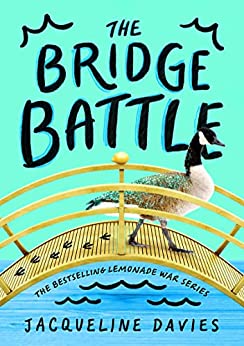Fond of precision and happiest when she’s in charge, nine-year-old Jessie Treski always says exactly what she means. Her brother in the fifth grade, Evan refers to his sister as “Obsessy Jessie” because of her intensity. Yet, Jessie looks to her big brother as someone “who always [has] the answers and who always [helps] her when she [can’t] figure things out on her own” (134). Furthermore, Evan will often play translator for his sister since Jessie considers feelings a mystery and finds reading people’s facial expressions confusing.
These two siblings play the role of protagonists in Jacqueline Davies’ latest book The Bridge Battle. Because Jessie’s mother sends the registration form in late for Summer Fun Exploration Camp, Jessie doesn’t get the class she hoped for: Young Engineers: Build Your Own Bridges. Instead, she’s enrolled in How to Make and Decorate Fairy Houses. Combining that with pooping geese, glitter, mean girls, and David Kirkorin, Jessie is not looking forward to the eight weeks of summer camp, where fairies, not physics, are the new curriculum.
Meanwhile, Evan has to enroll in summer school for support in reading and math. Here, he discovers—for the first time in his life—that he doesn’t belong and that the rules are different. “It was strange, he thought, that you could be exactly the same person in two different places. In one place, you were the king, but in the other place, you were the one who didn’t fit in” (65-66). At his elementary school, Evan is a “natural born leader,” both friendly and outgoing. Here at the middle school, he is the odd ball, nicknamed Goose Boy by Reed, a seventh grade bully. “Friendships in middle school were different from friendships in elementary school. In middle school, it was more like a battle strategy. It was more like World of Warcraft; alliances were formed, alliances shifted. People were thrown out of the circle, and that made room for others to join” (118).
In order to deflect Reed’s antagonism, Evan begins to dress differently and to play along with Reed’s antagonism of other students. He decides it is better to be on Reed’s good side than to be on his bad side. As he steals, bullies, and torments others to gain membership in the group, Evan realizes he no longer likes himself.
With both literal and figurative meaning, Evan’s reading tutor Miss Dixon tells him: “It always helps to have a backbone” (165). Eventually, Evan learns that boys like Reed “just act mean to try to make themselves feel big” (169).
With the metaphor of the keystone and the help of a pair of nesting geese, the two siblings not only learn about the power of invisible forces, which work “almost like magic,” but about the strength that is derived from working together. They also understand that as much as it feels good to get back at someone who has hurt you, revenge doesn’t always make a person feel better.
While exploring what it means to be socially part of the “in crowd” as well as what it feels like to be “out,” Davies’ book supports young engineers and celebrates the power of courage and kindness.
- Posted by Donna

